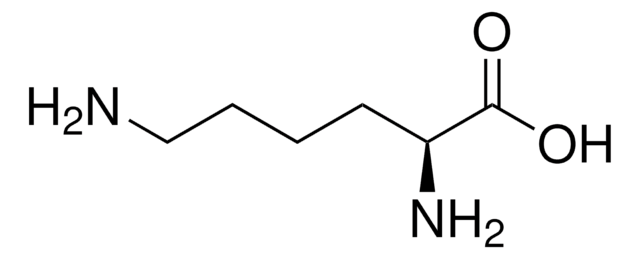62929
L-Lysine monohydrochloride
≥99.5% (AT), suitable for cell culture, BioUltra
Synonyme(s) :
(S)-2,6-Diaminohexanoic acid monohydrochloride
About This Item
Produits recommandés
product name
L-Lysine monohydrochloride, BioUltra, ≥99.5% (AT)
Gamme de produits
BioUltra
Niveau de qualité
Pureté
≥99.5% (AT)
Forme
powder or crystals
Activité optique
[α]20/D +20.5±0.5°, c = 5% in 5 M HCl
Technique(s)
cell culture | mammalian: suitable
Impuretés
insoluble matter, passes filter test
≤0.3% foreign amino acids
Résidus de calcination
≤0.1% (as SO4)
Perte
≤0.5% loss on drying, 20 °C (HV)
Couleur
white
pH
5.0-6.0 (25 °C, 0.5 M in H2O)
Pf
263 °C (dec.) (lit.)
Solubilité
H2O: 0.5 M at 20 °C, clear, colorless
Traces d'anions
sulfate (SO42-): ≤100 mg/kg
Traces de cations
Al: ≤5 mg/kg
As: ≤0.1 mg/kg
Ba: ≤5 mg/kg
Bi: ≤5 mg/kg
Ca: ≤10 mg/kg
Cd: ≤5 mg/kg
Co: ≤5 mg/kg
Cr: ≤5 mg/kg
Cu: ≤5 mg/kg
Fe: ≤5 mg/kg
K: ≤50 mg/kg
Li: ≤5 mg/kg
Mg: ≤5 mg/kg
Mn: ≤5 mg/kg
Mo: ≤5 mg/kg
NH4+: ≤100 mg/kg
Na: ≤50 mg/kg
Ni: ≤5 mg/kg
Pb: ≤5 mg/kg
Sr: ≤5 mg/kg
Zn: ≤5 mg/kg
λ
0.5 M in H2O
Absorption UV
λ: 260 nm Amax: 0.1
λ: 280 nm Amax: 0.1
Chaîne SMILES
OC([C@@H](N)CCCCN)=O.[H]Cl
InChI
1S/C6H14N2O2.ClH/c7-4-2-1-3-5(8)6(9)10;/h5H,1-4,7-8H2,(H,9,10);1H/t5-;/m0./s1
Clé InChI
BVHLGVCQOALMSV-JEDNCBNOSA-N
Vous recherchez des produits similaires ? Visite Guide de comparaison des produits
Description générale
Application
- to study its effect on mRNA decay and destruction using mammalian cells
- to determine its effec on aTC1-6 cell proliferation
- to study the dynamics of the phosphoproteome upon amino acid supplement removal in the growth medium
Actions biochimiques/physiologiques
Code de la classe de stockage
11 - Combustible Solids
Classe de danger pour l'eau (WGK)
WGK 2
Point d'éclair (°F)
Not applicable
Point d'éclair (°C)
Not applicable
Équipement de protection individuelle
Eyeshields, Gloves, type N95 (US)
Faites votre choix parmi les versions les plus récentes :
Déjà en possession de ce produit ?
Retrouvez la documentation relative aux produits que vous avez récemment achetés dans la Bibliothèque de documents.
Les clients ont également consulté
Notre équipe de scientifiques dispose d'une expérience dans tous les secteurs de la recherche, notamment en sciences de la vie, science des matériaux, synthèse chimique, chromatographie, analyse et dans de nombreux autres domaines..
Contacter notre Service technique










